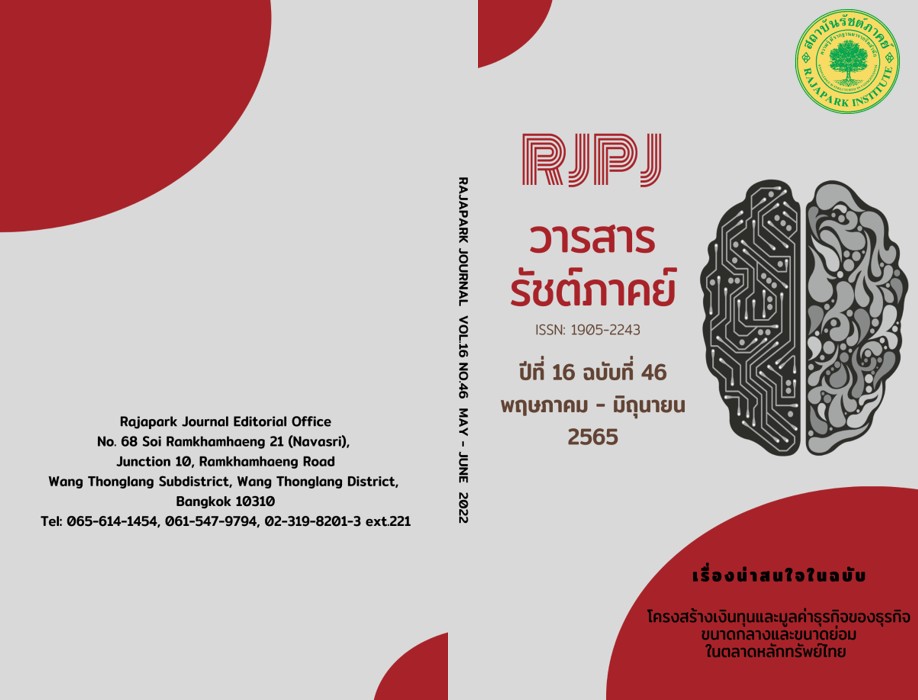Modern Organization Management of the Accounting Firm for the Transformation to a Digital Organization
Main Article Content
Abstract
This research aimed to study 1) The modern organization management of the accounting firm for the transformation to a digital organization 2) Study the factors of modern organization management of the accounting firm that influence the transformation to a digital organization It is quantitative research along with a qualitative one. The sample group used in this research was a bookkeeping service office located in Bangkok with 336 companies of 335 people. The researcher selects a sample that is the key informant. 7 executives/directors of quality accounting firms that have been certified by accounting firms by the requirements for accounting firm quality certification, or high-level executives in the private and public sectors concerned, namely: (1) Director-General of the Revenue Department (2) Director-General of the Department Business Development, (3) President of the Federation of Accounting Professions, (4) President of the Association of Accounting and Legal Firms, (5) President of the Thai Auditor General's Association, (6) Managing Director, VS Consulting and Accounting Company Limited, and (7) Director of the Company. Accounting The tool used was a statistical data analysis questionnaire which included percentage, mean, deviation, multiple regression, and Pearson's correlation coefficient. The results showed that the summary of the modern organizational management level of the accounting firm is organizational culture change human resource development Using technology to support work information security transparency and standards, attitudes and ethics in all aspects were at a high level.
Article Details

This work is licensed under a Creative Commons Attribution-NonCommercial-NoDerivatives 4.0 International License.
Views and opinions appearing in the Journal it is the responsibility of the author of the article, and does not constitute the view and responsibility of the editorial team.
References
Chaiprasit, C. (2019) Federation of Accounting Professions under the Royal Patronage of His Majesty the King. The New Auditor's Report Increases Transparency in the Audit of the Financial Statements. www.tfac.or.th/Article/Detail/126283
Cronbach, L. J. (1990). Essentials of Psychological Testing (5th ed.). Harper Collins.
Delahaye, B. L. (2004). Human Resource Development: Adult Learning and Knowledge Management (2nd ed.). John Wiley & Son.
Department of Business Development. (2021). Certified Accounting Practice. https://www.dbd.go.th/news_view.php?nid=5303
Intchan, R. (2009). Factors Affecting the Progress of Mission Transfer to the Organization. Local Government: A case study Sub-district Administrative Organization (SAO) in Nakhon Pathom Province[Doctoral Dissertation, Sripatum University].
Jaiyen, P. et al. (2017). Accountants with Modern Technology. Journal of Pacific Institute of Management Science, 3(1), 196-207. https://so05.tci-thaijo.org/index.php/pacific/article/view/203342/141825
Mainoy, A. (n.d.). Organization Efficiency Increasing. https://sites.google.com/site/mralongkotmainoy/kar-pheim-prasiththiphaph-khxng-xngkhkar
Permsirivallop, S. (2016). Technological Innovation Wave and Audit Profession. Journal of Accounting Profession, 12(34), 59-62. http://www.jap.tbs.tu.ac.th/files/Article/Jap34/Full/Jap34Sophon.pdf
Peter, T. J., & Waterman, R. H., Jr. (1982). In Search of Excellence: Lessons from America’s Best-Run Companies. Harper & Row.
Phuworawan, Y., & Naprasertchai, S. (2003). ICT for Education (2nd ed.). SE-EDUCATION.
Praditkul, T. (2020). Modern Organization and Management Theory. www.thaiprint.org/2020/12/vol128/knowledge128-03
Prapaisri, P., & Nuntapun, K. (2020). Professional Development Guidelines for Accounting Professionals in the Detrital Age. The University Central of Thailand.
Schein, E. H. (1992). Organizational Culture and Leadership (2nd ed.). Jossey-Bass.
Trice, H. M., & Beyer, J. M. (1984). Studying Organizational Cultures Through Rites and Ceremonials. The Academy of Management Review, 9(4), 653-669. https://doi.org/10.2307/258488
Wiratnipawan, W. (2010). Techniques for Creating and Mixing Combine Academic Concepts. http://wiruch.com/articles%20for%20article/article%20technic%20of%20Conceptual Framework%20writing.pdf
Wright, P.M., McMahan, G. C., & McWilliam, A. (1994). Human Resources and Sustained Competitive Advantage: A Resource-Based Perspective. International Human Resource Management Journal, 5(2), 299-324. https://doi.org/10.1080/09585199400000020
Wongthammakul, H. (1998). Utilization and Satisfaction with Information Technology Internet Networking of Students of Thammasat University[Master’s Thesis, Thammasat University].
Yamane, T. (1967). Statistics: An Introductory Analysis (3rd ed.). Harper & Row.


